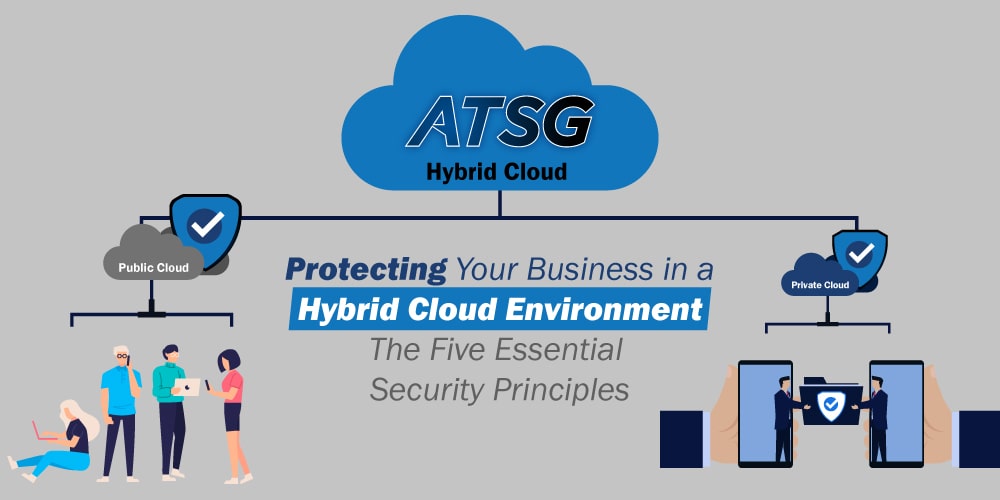Today, more and more businesses are embracing Cloud Computing Solutions to fuel their day-to-day operations. As a result, hybrid Cloud infrastructure has emerged as an increasingly popular, and “go-to” option for many enterprises. Its popularity is primarily due to the fact that a hybrid Cloud environment combines the benefits of both on-premise and fully Cloud-based solutions. This gives businesses the ability to maintain control over their sensitive data, while still taking advantage of the scalability, agility, and flexibility of the Cloud.
However, this hybrid Cloud approach does not come without its own unique set of security-related “trials and tribulations”. To counter this, it becomes crucial for businesses to take a proactive approach to Hybrid Cloud security.

For this reason, this blog is dedicated to exploring the ways in which businesses can secure their Hybrid Cloud solutions from malicious actors.
Understanding the Hybrid Cloud Environment
Before we dive into the core principles of hybrid Cloud security, we will take a look at what exactly does hybrid cloud infrastructure entail? Typically, a Hybrid Cloud environment refers to a mix of on-premise and Cloud-based resources.
For instance, an enterprise can leverage Private Cloud and Public Cloud for mission-critical workloads, and less critical workloads respectively. With the help of this combination, businesses not only have greater control over their sensitive data but can also take advantage of the numerous benefits of the Cloud.
In the following points, we highlight the five core principles that can be adopted by enterprises to protect their IT and Hybrid Cloud infrastructures.
Principle 1: Identifying and Classifying Data
When it comes to keeping hybrid Cloud systems secure, one of the biggest hurdles is figuring out what kind of data your business is handling, where it is being stored, and who can access it. Once you have that information, you can sort your data based on how sensitive it is, and what rules you need to follow to keep it safe. This helps enterprises converge their security-related “efforts and energies” on what matters the most. This way, enterprises will be able to make sure that their sensitive data is getting the best protection possible.
Principle 2: Securing Cloud Platforms and Services
Cloud platforms and services used in hybrid Cloud environments must be secured appropriately. These platforms may include Infrastructure as a Service (IaaS), Platform as a Service (PaaS), and Software as a Service (SaaS). Cloud Service Providers (CSPs) typically offer built-in security features, but businesses must also implement their own additional security layers, and cybersecurity best practices to protect their data. Enterprises must only engage with Cloud providers having an impeccable track record in cybersecurity. A proper understanding and thorough implementation of the shared responsibility model is essential for securing hybrid cloud deployments.
Principle 3: Network Security and Isolation
In a hybrid Cloud setting, network security, and isolation are critical to thwarting unauthorized access to data and resources. To make sure everything stays secure, the majority uses outdated solutions like Virtual Private Networks (VPNs) and only perimeter firewalls to keep their network connections safe.
Another trick is for businesses to adopt network segmentation that involves splitting up their network into different sub-sections. This way, enterprises can isolate their sensitive and confidential data from the rest of their digital assets. Remember, it is not just about the tools that businesses use. Having clear-cut policies and strategies in place is equally important to make sure everyone knows how to stay protected.
Principle 4: Identity and Access Management (IAM)
Similarly, Identity and Access Management (IAM) is crucial in ensuring only authorized users have access to sensitive data. It helps to manage user identities and access rights across various systems and applications, ensuring only authorized and authenticated users have access to resources.
Multi-factor authentication (MFA) further strengthens access level security, by requiring additional forms of authentication, beyond just static passwords. Both IAM and MFA help prevent data breaches, protect sensitive information, and maintain strong compliance with evolving regulatory requirements.
Principle 5: Continuous Monitoring and Risk Management
Finally, businesses must continuously monitor their hybrid Cloud environments for potential vulnerabilities and threats. Continuous monitoring allows for the identification of security incidents in real time. This helps businesses respond quickly to anomalies and prevent colossal damage. Risk management strategies must be put in place to mitigate potential risks that might menace the digital domain of an enterprise.
Conclusion
It is high time enterprises leverage the convenience and efficiency of the Cloud, with its multi-layered security as an added benefit. Though it can be tricky, is something that has to be done to ensure a robust cybersecurity posture.
By following the five core principles discussed in this blog, businesses can enjoy the scalability and flexibility of the Cloud, while still maintaining strong control and governance over their sensitive data.
If you don’t wish to lose your valuable data in today’s hybrid and multi-Cloud world, let ATSG be your “guardian angel”. ATSG offers businesses the necessary cybersecurity tools and supports to keep their data secure across Hybrid and Multi-Cloud environments.
ATSG’s Two Factor Authentication (2FA) mechanism adds an extra layer of security to your Cloud environment, ensuring that enterprise data is secure, even in the event of a password breach.
At ATSG, we also specialize in Zero Trust Architecture (ZTA), minimizing the risk of data breaches and ensuring that only authorized as well as authenticated users have access to sensitive enterprise data.




